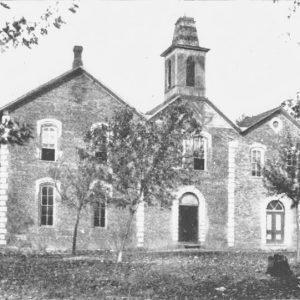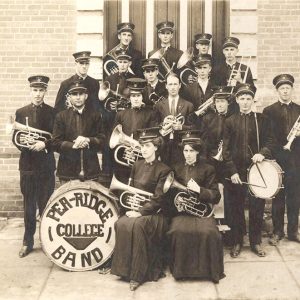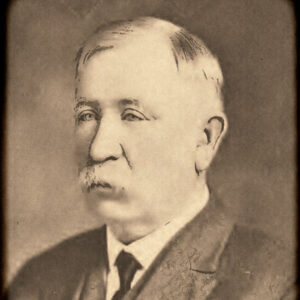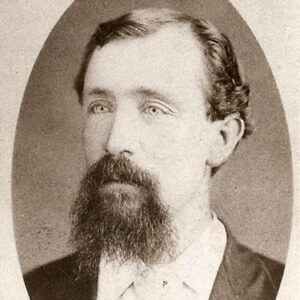calsfoundation@cals.org
Pea Ridge Academy
aka: Mount Vernon Normal College
aka: Mount Vernon Masonic College
aka: Pea Ridge Normal College
The Pea Ridge Academy, organized in 1874, was one of the earliest enduring institutions of higher education in the developing northwest Arkansas area following the Civil War. Contemporary with what is now the University of Arkansas (UA) in Fayetteville (Washington County) and the older Cane Hill College, the Pea Ridge Academy played a significant role in advancing education in Benton County. Organized as a private (or subscription) school, the academy soon entered a cooperative venture with the newly developing public school system, providing space for the public elementary and high school grades, while continuing to operate as a private trustee-governed academy offering college-level courses. Though never a large school, it sent out numerous graduates as business leaders and teachers for area schools. Two alumni who became widely known were William (Bill) Putman, founder of the long-enduring Putman’s Clothing Store in Bentonville (Benton County), and William H. Hughes, who had a significant career as an educator and newspaperman.
The Pea Ridge Academy—which would later be called Mount Vernon Normal College, and still later Mount Vernon Masonic College—originated in the Buttram’s Chapel community two miles southeast of the town of Pea Ridge (Benton County). The Reverend Elijah Buttram, a circuit-riding Methodist preacher with family roots in the local farming community, brought in Professor John Raines Roberts to be the headmaster of the new academy. For the first five years, from 1874 to 1879, classes were held in the two-story Buttram’s Chapel building. The Masonic lodge met upstairs, and the downstairs room served as space for church services, other community activities, and the new school. Professor Roberts’s sister, Nancy E. Roberts, taught the first five grades, while he taught the upper grades.
In the late 1870s, Roberts and his father purchased a fifteen-acre tract of land in the town of Pea Ridge, and work began on the new two-story brick schoolhouse which would become home to the academy. No school was held for the 1879–80 term, as all efforts were focused on completing the new building in Pea Ridge. The academy held its first classes there in the fall of 1880. In 1884, the University of Arkansas certified Pea Ridge Academy to offer a full range of courses, including college-level studies, and a major addition to the building in 1887 provided space for up to 250 students.
Financing the academy’s operation was always a challenge. In addition to student tuition, the academy relied on local patrons and supporters to invest in its program. Many supporters bought “shares” in the college, and other contributors were cultivated. Masonic lodges seem to have played a major supportive role throughout the school’s history, and their financial support was especially important in the early 1900s.
In 1894, the academy’s financial difficulties became acute, and Professor Roberts was unable to continue. After teaching briefly in Bentonville, he returned to his native state of Missouri, eventually becoming a school administrator in Springfield and still later pursuing a law career and serving as a judge. After Roberts’s departure, a new administration led by B. H. Caldwell reorganized the school as Mount Vernon Normal College, also known as the Pea Ridge Normal College. (The name “Mount Vernon” comes from the Mount Vernon township in which the town of Pea Ridge is located.) Commencement materials from 1895 show that—in addition to the teacher-training programs suggested by the school’s new name—music, literature, and other humanities programs were important in the curriculum. Benton County historian J. Dickson Black reports that, in 1902, the college was advertising itself as one of the best business schools in Arkansas.
In 1904, the college went through a second reorganization. Details of the circumstances are sketchy, but it seems a group of nine Masonic lodges teamed together to sponsor the college’s operation. The school adopted the new name Mount Vernon Masonic College, although the institution’s other names would endure in popular usage through and beyond the active life of the college.
Few details are known regarding the closing years of the college in Pea Ridge. It seems reasonable to suppose that the financial challenges that plagued the school throughout its history, along with competition from larger state-supported colleges, were major factors that finally led to the school’s closing in 1916. At that time, the college building and campus acreage were deeded to the Pea Ridge Public School. The old 1880s college building continued housing the public school through the 1929–30 school term. It was dismantled in May 1930 to make way for a new, more modern-styled one-story schoolhouse. Nancy Roberts stayed on, teaching children in the Pea Ridge Schools until her retirement in 1926.
For additional information:
Black, J. Dickson. History of Benton County. Little Rock: International Graphics Institute, 1975.
Crabtree, Jackie, et al. Pea Ridge, 1850–2000: Anchored to the Past…Rising to the Future. Rich Hill, MO: 2000.
Joe Jerry Nichols
Pea Ridge Historical Society
 Pea Ridge Academy
Pea Ridge Academy  Pea Ridge College Band
Pea Ridge College Band  John Roberts
John Roberts  John Roberts
John Roberts 




Comments
No comments on this entry yet.